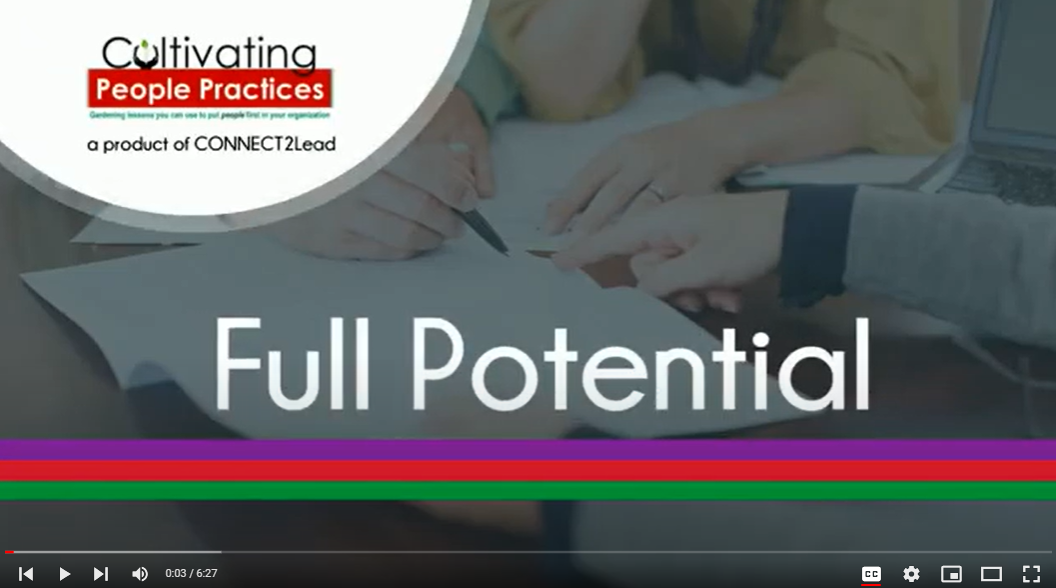Cultivating People to Reach their Full Potential
Transcript
Are you doing everything you can to make the people in your organization feel like they belong? That you want them to be there? That you're interested in nurturing them and developing them so that they can reach their full potential? It all starts before day one in your organization, before you ever bring people in for training and onboarding. You want to be sure that the environment is right, that you have a culture and a process and a plan to help them be successful.
That means that you've weeded out anything that might interfere with their ability to thrive. It means that you've laid the foundation. You've created ways for them to be really healthy and strong. It means that you have thought about them as individuals because not everyone needs exactly the same thing. It also means that you have set aside time to work with them.One of the most heartbreaking things I see when I go in to consult with organizations is when they tell me we have a revolving door here. "We can't seem to keep people. There just aren't any good people available anymore." And, well, that's just not true.
There are lots of good people. The problem is that they don't feel like they can be at their best with you. It happens when they come to work on day one and no one is there to greet them. And then they get locked in a room for the first three days to fill out paperwork and watch videos and have barely any interaction with you or with anybody else on the team. And then suddenly they're supposed to hit the ground running and it's hard for them to ask questions and to get the support that they need.
And of course, they're probably at the same time beginning to hear some grumbles of the people who already work there. Why would they stay? Of course you have a revolving door. In fact, you are the one who's holding that door open and pushing people through it. You can do better. You can have a great environment where people can thrive, where their needs are met and where they will grow and flourish and produce high yield for you and your organization. It really is easy to grow just about anything in straw bales, but you have to do a little bit of preparation.
On its own, straw isn't the best medium for growing any sort of produce because it's not amended. Even soil has to be amended to have the right nutrients for those poor little plants to get what they need. So getting to a point like this where your plants are flourishing, whether they like the celery on the left go directly into the straw, or whether like these broccoli and cauliflower, they need a little bit of compost and maybe even some dirt when you transplant them.
Getting to that point doesn't start right there. It starts earlier for me. It starts in February, when it's still cold outside, we get the straw bales delivered and the first thing we do is heavily water them and then we begin conditioning them. That white stuff you see there in the middle, that is nitrogen, pure nitrogen or urea. And the reason we use that at first about a cup at a time over the course of two weeks, spreading it on the straw bales every other day.
The reason we do that is because nitrogen breaks down the middle of the straw bale just enough it decomposes enough to be a really good growing medium. It helps the inside of the straw bale to heat up. And that way the root vegetables, they don't hit a barrier of hard packed straw and the plants with more delicate root systems are also able to put those roots down more quickly.
Now, later on, we're going to add some other nutrients depending on the needs of the individual plants. But conditioning the straw before any plant ever goes into it is extremely important. And the same is true with the work that you do. Creating fertile ground so that you can grow the business, so that you can grow the people that you're working with is absolutely essential when you do a really good job of creating the perfect foundation, everything you grow is going to be healthier. It'll grow faster, it'll produce more, it will be glad to be a part of your garden because your garden is where it's being fed.
And in return, when you feed what's in your own garden, your garden will feed you. Your garden will have high yield. Your garden will give you everything that you're asking it to give you because you've made it possible. You've planned and you've thoughtfully prepared so that you are able to enjoy the fruits of your labor long term. Isn't that what it's all about? But it does start with putting people first, just like in my straw bale garden, it starts with thinking about the environment that my little vegetables are going to need to have if they're ever to produce and give me delicious results at the end of the season.

